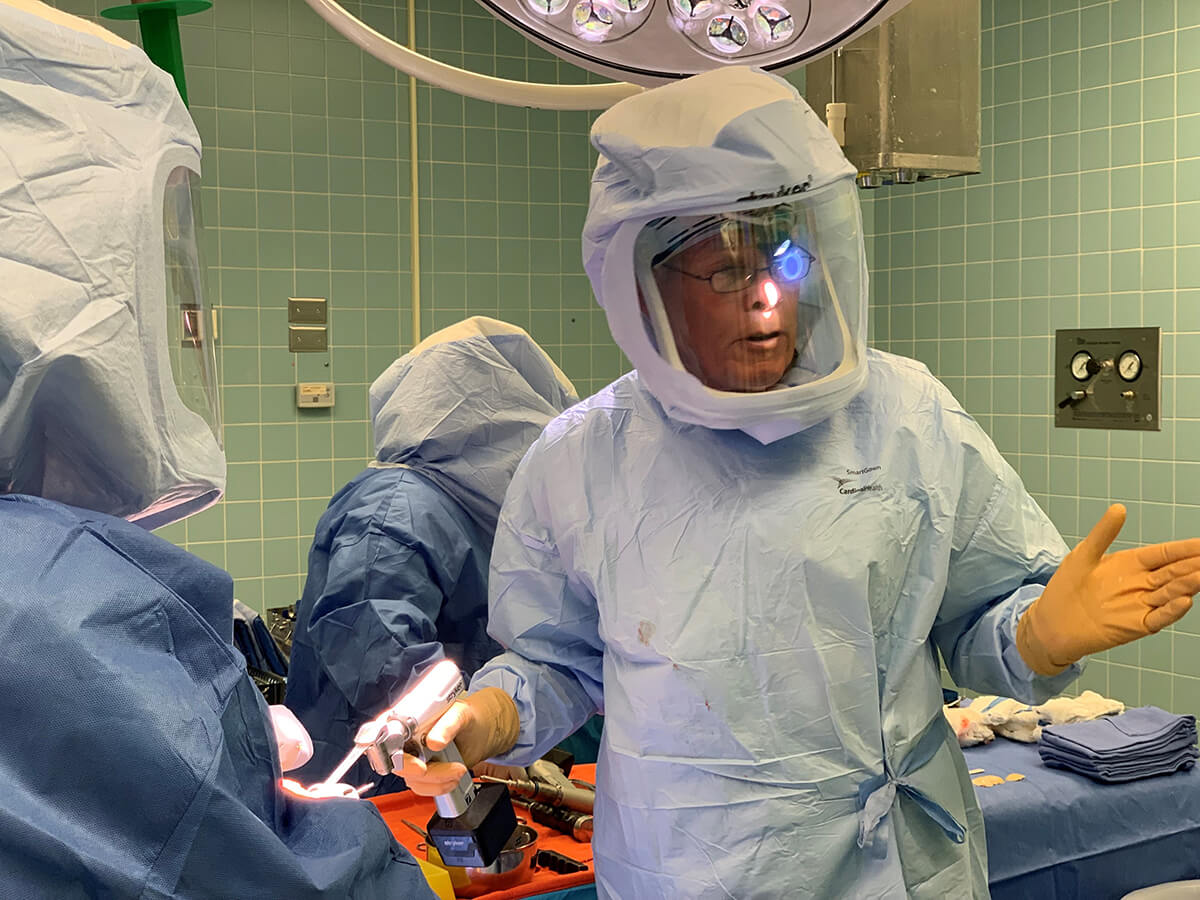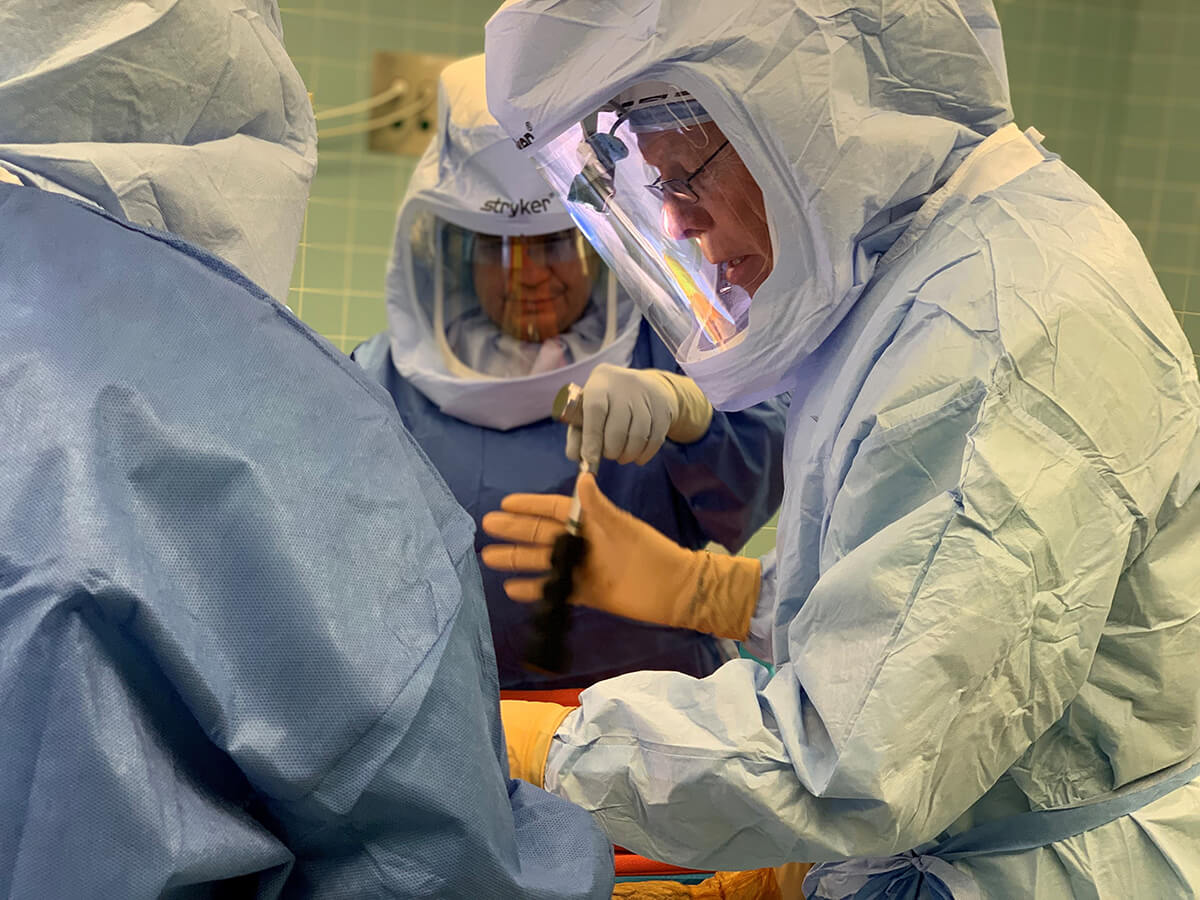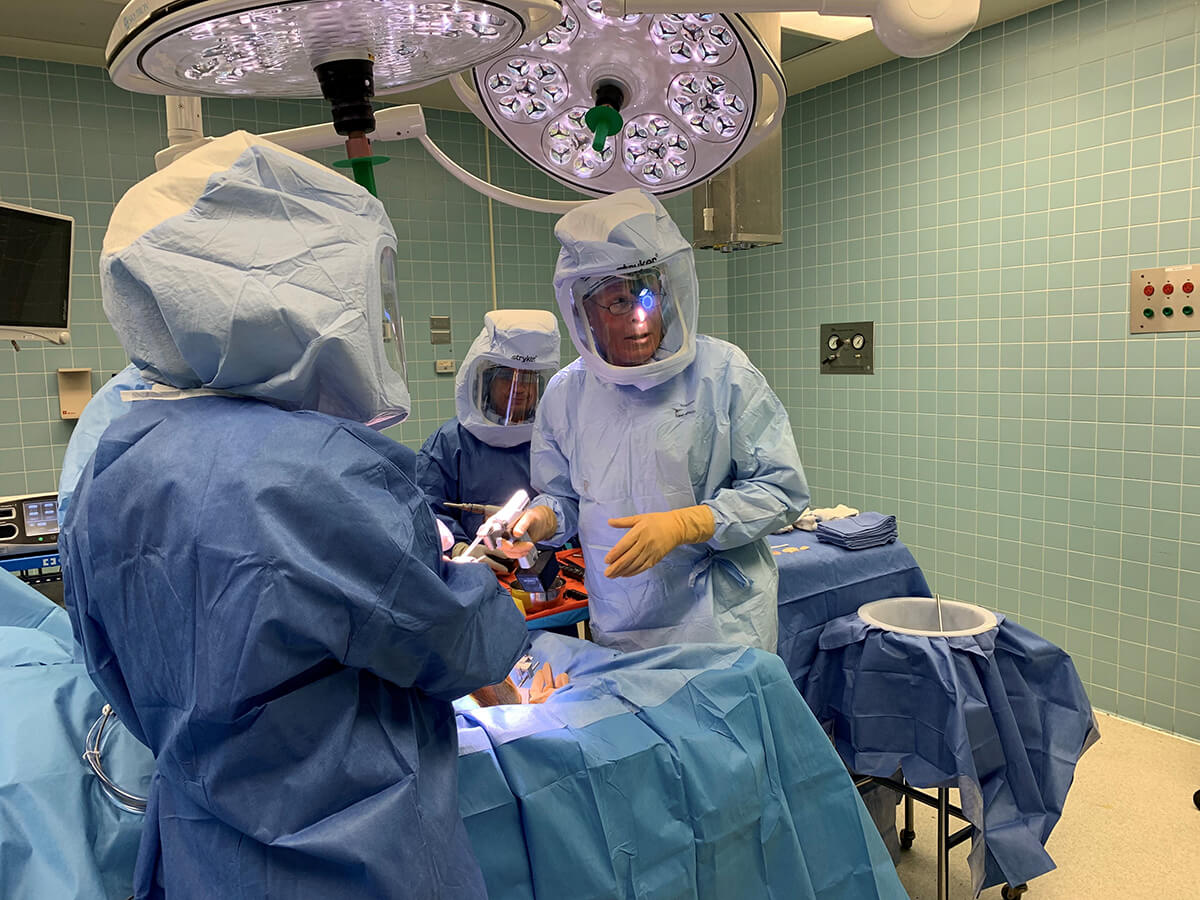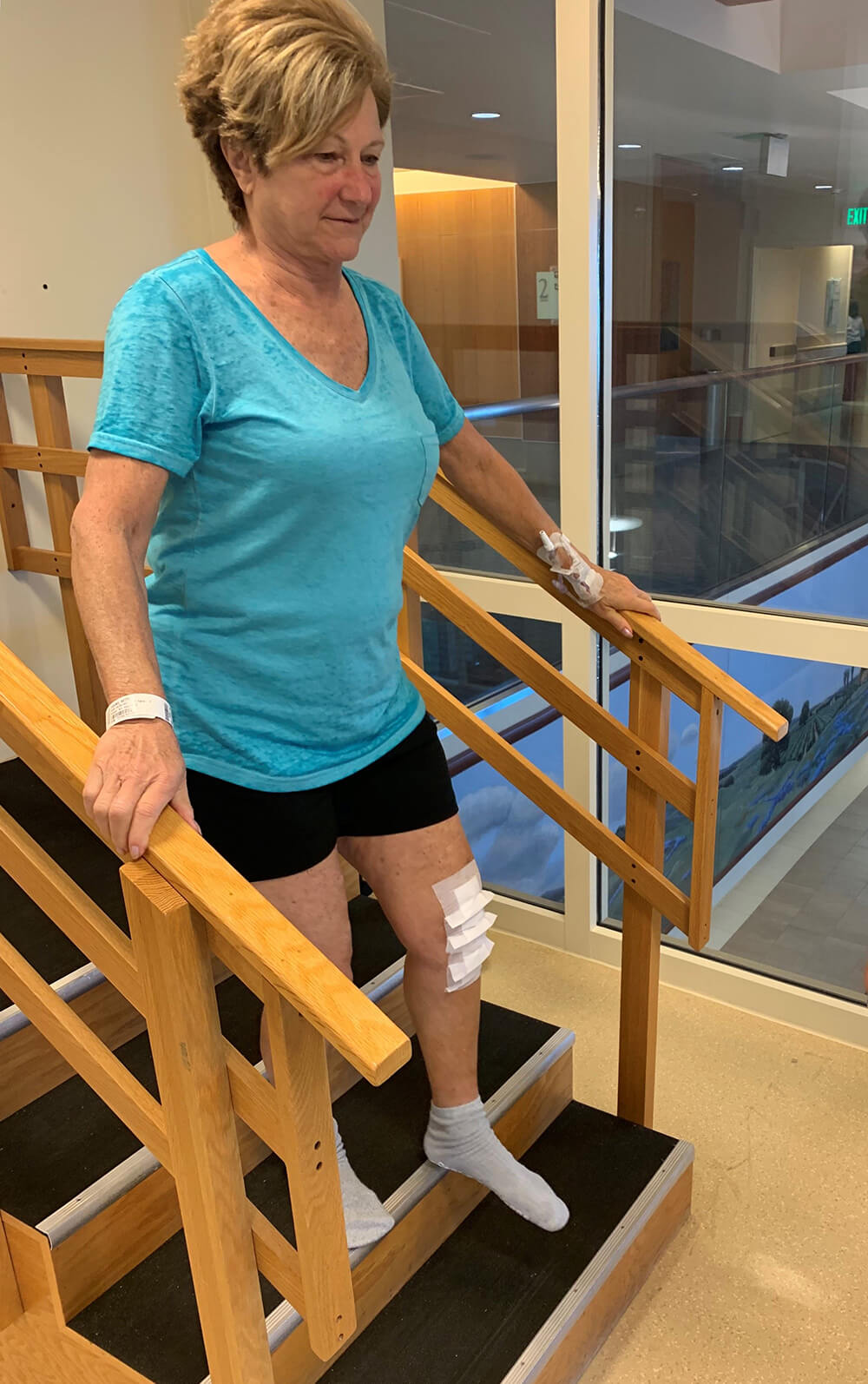Betty Young lies on the operating room table, only her left leg exposed in a sea of sterile blue drapes. An anesthesiologist keeps a watchful eye at the head of the table, and gowned surgery staff scurry around the starkly lit room, doing final checks of monitors, charts and instruments while two surgeons scrub up on the other side of a glass window.
The doctors enter the room, with its subtle, constant, beeping, and they gather with the assistants and techs around the table. Everyone’s focus is on one thing: Young’s knee, glowing bright under one spotlight.
It is time. Young has waited years to walk without knee pain. Today, she plans to wake up and go for a walk.
For Dr. Stephen Howell, it’s a typical Monday morning. He walks into an operating room, sometimes six a day, where painful and swollen knees are waiting for his perfected procedure that has many patients walking 90 minutes later. Today, as he has been around the globe, he is also a teacher.
Australian-trained orthopedic surgeon Dr. Jorgen Hellman is visiting the operating room at Adventist Health Lodi Memorial Medical Center to watch Howell, the Lodi-based world-renowned surgeon, perform the kinematic aligned total knee replacement.
Developed by Howell, TKR uses 3D technology to map the native joint line of the knee as it was before arthritis develops. This FDA-approved kinematic alignment allows for a custom, individualized placement of the implant in the knee for each patient, allowing for better outcomes. Patients see faster recovery times, pain relief, function and flexion, as well as improved implant survival.
“Seeing Dr. Howell do the operation physically and being there in the operating theater gels everything together,” Hellman said. “Actually seeing the technique in person and being present for the surgery is a much more valid way of learning the procedure.”
Howell teaches his kinematic alignment to surgeons worldwide to offer patients a second chance at mobility. He has trained surgeons in the United States, England, France, Germany, Israel, Switzerland, Italy, Australia, Japan and China. Since 2018, Howell has hosted 26 international surgeons and 12 U.S. surgeons in Lodi. Today, he is excited to have Hellman in his operating room to fine-tune techniques and refine the total knee replacement process.
The sterile operating theater, with its dressed tables topped with drills, bits, hammers, pliers, hooks and other instruments, is packed today. At center stage is Young, the 68-year-old patient Howell has come to know through her terrible bouts of knee pain. Here she is on his operating table, his first surgery of the day. He is giving her the new knee she hopes will restore the freedom of taking long walks and doing once-simple tasks, like getting out of a car, easily.
Once it starts, the surgery appears to be a fluid dance between a troupe who each know the others’ next moves. Howell presses into a bit with a drill, and when he pulls back, physician assistant Tom Carmody moves the bit slightly and a surgery nurse hands Howell a new drill. Howell rarely has to look up from the open knee, nor does he have to ask for much. They know what he needs. He pushes and pounds and pokes. There is a series of sounds with each pound, chisel and saw. Then, it stops and Carmody removes a small piece of bone – the pain culprit – that he hands to Howell to measure with a caliper.
“This should be a six, which it is. And this should be an eight, which it is,” Howell says, holding it up to Hellman with a big smile.
Accurate. Just as Howell expected.
Howell is excited by the precision, largely because this measurement is what makes a surgery successful. The piece of bone removed needs to be the same size as the implant. If he removes more than necessary, the patient could end up with a recessed implant or loose-feeling knee. If he doesn’t remove enough, the implant could protrude or feel tight.
“By reducing the risk using these caliper measurements and verifying these checks in the operating room, the risk of a stiff knee and unpleasant knee goes down,” Howell said. “It increases the likelihood that a patient has a simpler recovery and can return to the activities they want, including many sports.”
Hellman, keeping a close eye on every motion of Howell’s handiwork on Young’s knee, is no stranger to Howell or the knee procedure he developed. Hellman has also been performing knee replacement surgeries for 15 years, and learned about Howell’s method when he spoke at an international meeting in Switzerland five years ago. Hellman performs 300 total-knee replacements annually and is what Dr. Howell calls Australia’s own pioneer in total-knee replacement.
Along with his own research, Hellman saw patient satisfaction increase with the kinematic alignment, compared to the more traditional, older technique.
“For the past four years I have been using the same technique and the results have been very impressive,” he said.
Carole Addington of Lodi has been on Howell’s operating table twice, once for each of her knees. Her first surgery was in August 2018, and the second surgery was in January. Years of excruciating pain led her to a meniscus surgery and steroid treatment, both of which gave her only temporary relief.
“Everything would work for a while, but got to the point where I was just so miserable,” she said.
Through word of mouth, she learned about Howell and his total-knee replacement procedure, and after eight months, she feels like she has a newfound freedom. Her knew knees allow her and her husband, Ron, to continue on adventures and be the “vagabonds that we are,” she said, and see the world.
“We just got back from 11 days in Canada, where we climbed on a bus 10 times a day, up and down the steps, and we walked and walked and walked,” she said. “I never thought once about my knees. They were just incredible.”
Howell has operated on nearly 1,000 knee-replacement patients in the two years he has been practicing at Adventist Lodi Memorial – and the reactions are often very similar to Addington’s.
As Howell and Hellman’s surgical day wraps up around 2 p.m., after six cases in the operating room, they walk together through the halls of Adventist Health Lodi Memorial to make rounds on the day’s patients.
Howell stands in the doorway of Room 261 and throws up his arms to greet a smiling Betty Young and her family.
“I just went for a walk,” she announces, smiling, adding that it was already her third walk of the day after surgery four hours earlier.
He’s not surprised. He encourages all his patients to get up and walk, sometimes even 90 minutes after they get out of surgery. At her bedside, Howell pulls back the blanket and tells her to move her knee. Slowly and with a smile, she bends her knee.
“Show me 90 degrees,” he encourages.
“I can do 90 degrees,” she assures him.
Young, though a little sore, is excited for the weeks ahead. The day before, she couldn’t walk minutes at a time without being in pain. Now, she is looking forward to her fast-paced walks of two to three miles without a problem. She will get there, she knows. She has gone this far. “I’m kind of proud of myself,” she said.
Dr. Howell covers her leg and reminds her about her follow-up appointment before he heads out to see other patients. She thanks him, and it’s obvious she genuinely means it.
“He’s the man. He’s the go-to,” she says after he leaves her room. “Ask anyone.”




